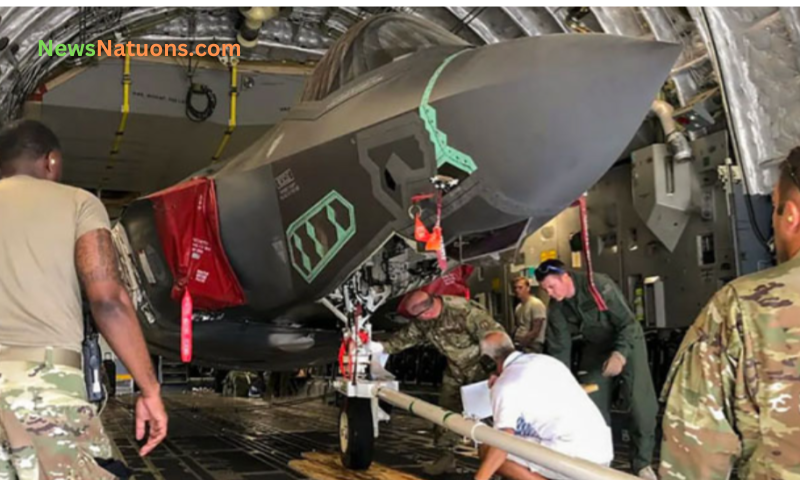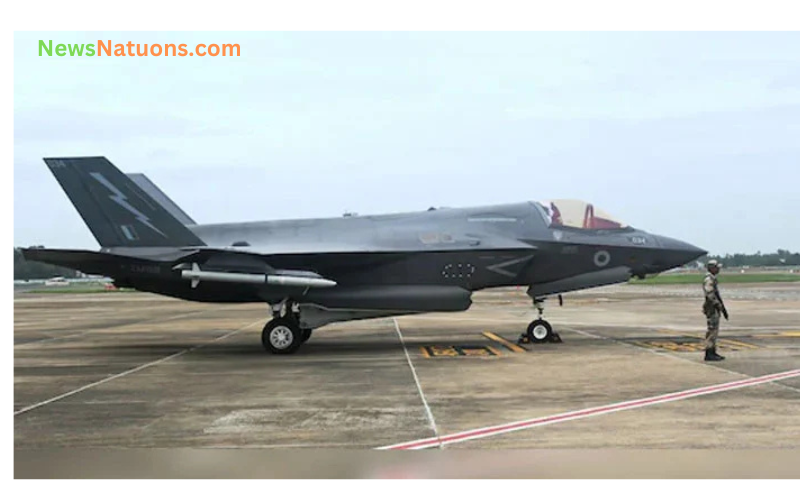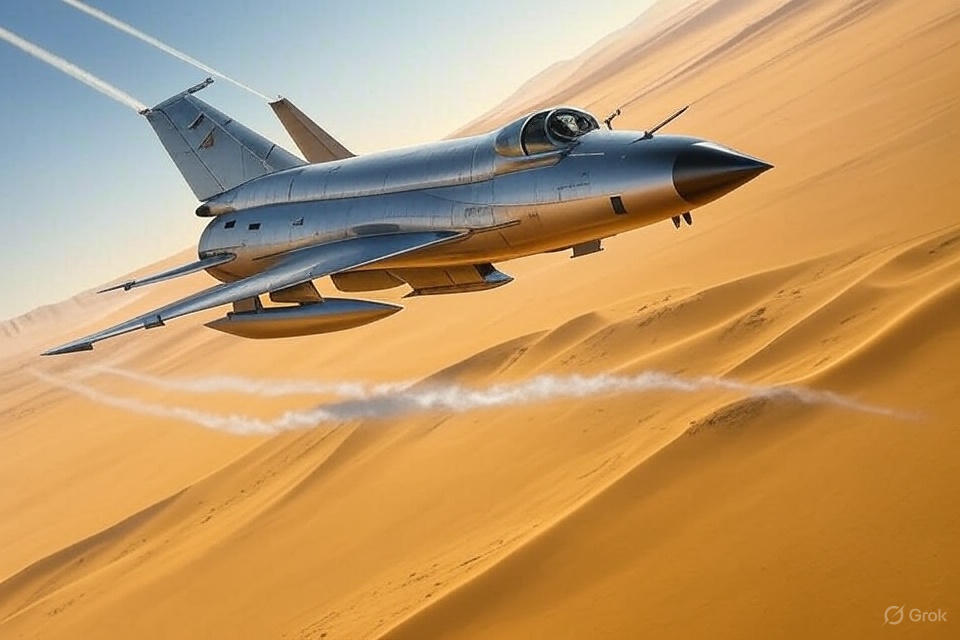On June 14, 2025, a British Royal Navy F-35B Lightning II stealth fighter jet, valued at over $110 million, made an emergency landing at Thiruvananthapuram International Airport in Kerala, India, and has remained grounded for nearly three weeks, as reported by India Today (June 25, 2025). The jet, part of the HMS Prince of Wales Carrier Strike Group, was forced to divert due to a combination of adverse weather conditions and critically low fuel levels during a routine maritime exercise in the Indian Ocean. Despite initial support from the Indian Air Force, including refueling and logistical assistance, the aircraft’s departure was halted by a hydraulic system failure detected during pre-flight checks. The situation has drawn significant attention, with ongoing repair attempts proving unsuccessful and the Royal Navy now considering dismantling and airlifting the jet back to the UK via a military cargo plane, highlighting both technical challenges and the complexities of handling sensitive military technology abroad.
Emergency Landing and Initial Response
The F-35B, operating outside India’s Air Defence Identification Zone, encountered severe monsoon weather approximately 100 nautical miles off Kerala’s coast, rendering a return to HMS Prince of Wales unsafe. The pilot, identified as Captain Mike, issued a distress signal (SQUAWK 7700) around 9:30 PM IST, prompting swift coordination by the Indian Air Force’s Integrated Air Command and Control System to facilitate a safe landing at Thiruvananthapuram, a pre-designated emergency recovery airfield (The Independent, June 26, 2025). The Indian Air Force provided immediate support, including refueling, but a hydraulic failure discovered during departure preparations grounded the jet. A small Royal Navy team, airlifted via an AW101 Merlin helicopter, attempted repairs but was unable to resolve the issue, necessitating a larger specialist team from the UK (NDTV, June 21, 2025).
Hydraulic Failure and Repair Challenges
The hydraulic system, critical for the F-35B’s short take-off and vertical landing (STOVL) capabilities, including its lift fan and control surfaces, is a sophisticated component. The failure, identified as a major fault, has proven too complex for the initial team of three technicians and a replacement pilot, as reported by Business Standard (July 3, 2025). Despite multiple repair attempts, the jet remains stranded at Bay 4 of the airport, exposed to Kerala’s monsoon rains, which have been exacerbated by an orange alert for heavy rain and winds (Indian Defence Research Wing, June 22, 2025). The delay in deploying a 30- to 40-member UK engineering team, expected to bring specialized equipment, has further prolonged the situation, with no clear timeline for resolution (India Today, June 27, 2025).
Security and Monsoon Concerns
The F-35B, guarded round-the-clock by India’s Central Industrial Security Force (CISF), has been parked in the open near the domestic terminal, raising concerns about exposure to monsoon conditions and potential security risks to its advanced stealth technology (The Independent, June 26, 2025). Initially, the Royal Navy declined Air India’s offer to move the jet to a hangar, citing concerns over protecting its sensitive technologies, including stealth coatings and sensor fusion systems (NDTV, June 20, 2025). However, after nearly two weeks of exposure to rain, the Royal Navy reversed this decision, agreeing to shift the jet to a Maintenance, Repair, and Overhaul facility hangar once a special tow vehicle and the UK team arrive (India Today, June 27, 2025). This move aims to protect the aircraft while minimizing disruptions to airport operations.
Consideration of Airlift to the UK
With on-site repairs proving unfeasible, the Royal Navy is now contemplating dismantling the F-35B and transporting it back to the UK via a military cargo aircraft, likely an RAF C-17 Globemaster III (Business Standard, July 3, 2025). This approach mirrors the 2021 recovery of a crashed UK F-35B from the Mediterranean, where sensitive wreckage was retrieved to prevent technology leaks (Indian Defence Research Wing, June 22, 2025). The decision to airlift reflects the complexity of the hydraulic issue and concerns about prolonged exposure of the jet’s advanced systems, valued for their radar-evading capabilities and data-sharing infrastructure (Bulgarian Military, July 1, 2025). The operation, if executed, underscores the logistical and diplomatic challenges of handling a fifth-generation fighter in a non-NATO country.
India-UK Defense Cooperation
The incident highlights the deepening defense ties between India and the UK, with the Indian Air Force and CISF providing exemplary support. A British High Commission spokesperson expressed gratitude, stating, “The safe landing, logistics, and continuing security support provided by India further demonstrates the close coordination between our armed forces” (The Independent, June 27, 2025). Despite social media speculation about espionage risks, British officials have dismissed concerns, emphasizing trust in their Indian allies (The Independent, June 27, 2025). The joint maritime exercises prior to the landing, part of the HMS Prince of Wales’ Operation Highmast in the Indo-Pacific, further underline this partnership (National Interest, June 25, 2025).
Public and Media Reactions
The stranded F-35B has captured global attention, with Indian media outlets like The Hindu and Times of India detailing the technical and diplomatic nuances (The Hindu, June 25, 2025; Times of India, June 22, 2025). Social media, particularly X, has been abuzz with posts ranging from serious analyses to humorous takes, such as Kerala Tourism’s cheeky claim that the jet is simply enjoying an extended “staycation” in “God’s Own Country” (India Today, July 2, 2025). Posts by @NavyLookout and @ShivAroor on X reflect the mix of curiosity and levity surrounding the incident, with some questioning the jet’s prolonged grounding and others praising India’s hospitality (X posts, June 15–25, 2025).
Implications for the F-35 Program
The grounding raises questions about the F-35B’s maintenance challenges, a recurring issue noted in a 2024 U.S. Department of Defense report highlighting frequent critical failures and extended repair times (Bulgarian Military, July 1, 2025). The jet’s advanced systems, while cutting-edge, require specialized expertise, as evidenced by the delay in deploying a UK team (Firstpost, June 25, 2025). The incident also tests the F-35 program’s reliability during global operations, particularly in non-NATO environments, and underscores the need for robust contingency plans for advanced military assets (National Interest, June 25, 2025).
Future Steps and Challenges
As the Royal Navy awaits the arrival of its engineering team and a special tow vehicle, the focus remains on either repairing the jet on-site or preparing it for airlift. The operation, if it proceeds, will require careful coordination to protect the jet’s sensitive technologies, with the CISF continuing to ensure security (India Today, June 27, 2025). The prolonged grounding, now approaching three weeks, has sparked discussions about potential parking charges and the logistical burden on Thiruvananthapuram airport (India Today, June 27, 2025). The incident serves as a reminder of the complexities of maintaining advanced military aircraft and the importance of international cooperation in such scenarios.
A Test of Resilience and Diplomacy
The stranded F-35B in Kerala encapsulates both the technical sophistication and vulnerabilities of modern warfare technology. The Royal Navy’s cautious approach to repairs reflects concerns about safeguarding the jet’s stealth capabilities, while India’s support highlights a strong bilateral relationship. As reported by The Independent (June 27, 2025), the longer the jet remains grounded, the greater the scrutiny it faces, yet the collaboration between the two nations remains a positive aspect. The eventual resolution—whether through repair or airlift—will likely set a precedent for handling similar incidents involving advanced military assets abroad.
14 جون 2025 کو برطانوی رائل نیوی کا ایف-35 بی لائٹننگ II اسٹیلتھ لڑاکا طیارہ، جس کی قیمت 110 ملین ڈالر سے زائد ہے، کیرالہ کے تھرواننتھاپورم انٹرنیشنل ایئرپورٹ پر ہنگامی لینڈنگ کے بعد سے تقریباً تین ہفتوں سے زمین پر ہے، جیسا کہ انڈیا ٹوڈے (25 جون 2025) نے رپورٹ کیا۔ یہ طیارہ ایچ ایم ایس پرنس آف ویلز کیرئیر اسٹرائیک گروپ کا حصہ تھا اور بھارتی بحریہ کے ساتھ معمول کے بحری مشقوں کے دوران خراب موسم اور کم ایندھن کی وجہ سے ہنگامی لینڈنگ کرنا پڑی۔ بھارتی فضائیہ کی ابتدائی مدد، بشمول ایندھن اور لاجسٹک سپورٹ، کے باوجود، پری فلائٹ چیکس کے دوران ہائیڈرولک نظام کی خرابی نے طیارے کے روانگی کو روک دیا۔ ناکام مرمتی کوششوں کے بعد، رائل نیوی اب طیارے کو کھول کر فوجی کارگو طیارے کے ذریعے برطانیہ منتقل کرنے پر غور کر رہی ہے، جو حساس فوجی ٹیکنالوجی سے نمٹنے کے تکنیکی اور سفارتی چیلنجز کو اجاگر کرتا ہے۔
ہنگامی لینڈنگ اور ابتدائی ردعمل
ایف-35 بی، جو بھارت کے ایئر ڈیفنس آئیڈنٹیفکیشن زون سے باہر آپریٹ کر رہا تھا، کیرالہ کے ساحل سے تقریباً 100 ناٹیکل میل دور شدید مون سون موسم کا شکار ہوا، جس نے ایچ ایم ایس پرنس آف ویلز پر واپسی کو غیر محفوظ بنا دیا۔ پائلٹ، کیپٹن مائیک، نے رات 9:30 بجے IST کے قریب ہنگامی سگنل (SQUAWK 7700) جاری کیا، جس کے بعد بھارتی فضائیہ کے انٹیگریٹڈ ایئر کمانڈ اینڈ کنٹرول سسٹم نے تھرواننتھاپورم، ایک پیشگی نامزد ہنگامی ریکوری ایئر فیلڈ، پر محفوظ لینڈنگ کی سہولت دی (دی انڈیپینڈنٹ, 26 جون 2025)۔ بھارتی فضائیہ نے فوری طور پر ایندھن فراہم کیا، لیکن روانگی کی تیاری کے دوران ہائیڈرولک خرابی کا پتہ چلا۔ رائل نیوی کی ایک چھوٹی ٹیم، جسے AW101 Merlin ہیلی کاپٹر کے ذریعے لایا گیا، نے مرمت کی کوشش کی لیکن ناکام رہی، جس سے برطانیہ سے ایک بڑی ماہر ٹیم کی ضرورت پڑی (NDTV, 21 جون 2025)۔
ہائیڈرولک خرابی اور مرمتی چیلنجز
ایف-35 بی کا ہائیڈرولک نظام، جو اس کی شارٹ ٹیک آف اینڈ ورٹیکل لینڈنگ (STOVL) صلاحیتوں، بشمول لفٹ فین اور کنٹرول سرفیسز کے لیے اہم ہے، ایک پیچیدہ جزو ہے۔ اس خرابی کو ایک بڑی خامی کے طور پر شناخت کیا گیا، جو تین تکنیکی ماہرین اور ایک متبادل پائلٹ کی ابتدائی ٹیم کے لیے ناقابل حل ثابت ہوئی (بزنس اسٹینڈرڈ, 3 جولائی 2025)۔ طیارہ ایئرپورٹ کے بے 4 پر کھڑا ہے، جہاں کیرالہ کی مون سون بارشوں، جو شدید بارش اور ہواؤں کے لیے اورنج الرٹ کے تحت ہیں، نے حالات کو مزید پیچیدہ کر دیا (انڈین ڈیفنس ریسرچ ونگ, 22 جون 2025)۔ 30 سے 40 رکنی برطانوی انجینئرنگ ٹیم کی تاخیر نے صورتحال کو طول دیا (انڈیا ٹوڈے, 27 جون 2025)۔
سیکیورٹی اور مون سون کے خدشات
ایف-35 بی کو بھارت کی سینٹرل انڈسٹریل سیکیورٹی فورس (CISF) کے ذریعے چوبیس گھنٹے حفاظت فراہم کی جا رہی ہے، لیکن یہ ڈومیسٹک ٹرمنل کے قریب کھلے میں کھڑا ہے، جو مون سون حالات اور اس کی جدید اسٹیلتھ ٹیکنالوجی کے لیے سیکیورٹی خطرات کا باعث ہے (دی انڈیپینڈنٹ, 26 جون 2025)۔ ابتدا میں، رائل نیوی نے ایئر انڈیا کی ہینگر میں منتقل کرنے کی پیشکش کو حساس ٹیکنالوجیز، جیسے اسٹیلتھ کوٹنگز اور سینسر فیوزن سسٹمز، کی حفاظت کے خدشات کی بنا پر مسترد کر دیا (NDTV, 20 جون 2025)۔ تاہم، تقریباً دو ہفتوں کی بارشوں کے بعد، رائل نیوی نے فیصلہ تبدیل کیا اور ایک خصوصی ٹو گاڑی اور برطانوی ٹیم کے پہنچنے پر طیارے کو مینٹیننس، ریپیئر اینڈ اوور ہال ہینگر میں منتقل کرنے پر اتفاق کیا (انڈیا ٹوڈے, 27 جون 2025)۔
برطانیہ منتقل کرنے پر غور

موقع پر مرمت ناکام ہونے کے بعد، رائل نیوی اب ایف-35 بی کو کھول کر RAF C-17 Globemaster III کے ذریعے برطانیہ منتقل کرنے پر غور کر رہی ہے (بزنس اسٹینڈرڈ, 3 جولائی 2025)۔ یہ طریقہ 2021 میں بحیرہ روم میں گر کر تباہ ہونے والے ایف-35 بی کی بازیابی سے ملتا جلتا ہے، جہاں حساس ٹیکنالوجی کی حفاظت کے لیے خصوصی سامان استعمال کیا گیا (انڈین ڈیفنس ریسرچ ونگ, 22 جون 2025)۔ ایئرلفٹ کا فیصلہ ہائیڈرولک مسئلے کی پیچیدگی اور طیارے کے جدید نظاموں کی طویل نمائش کے خدشات کی عکاسی کرتا ہے (بلغاریئن ملٹری, یکم جولائی 2025)۔
بھارت-برطانیہ دفاعی تعاون
یہ واقعہ بھارت اور برطانیہ کے درمیان گہرے ہوتے دفاعی تعلقات کو اجاگر کرتا ہے، جہاں بھارتی فضائیہ اور CISF نے مثالی تعاون فراہم کیا۔ برطانوی ہائی کمیشن کے ترجمان نے کہا، “محفوظ لینڈنگ، لاجسٹک، اور مسلسل سیکیورٹی سپورٹ بھارت اور برطانیہ کی افواج کے درمیان گہرے تعاون کی عکاسی کرتی ہے” (دی انڈیپینڈنٹ, 27 جون 2025)۔ سوشل میڈیا پر جاسوسی کے خدشات کے باوجود، برطانوی حکام نے ان کو مسترد کرتے ہوئے بھارتی اتحادیوں پر اعتماد کا اظہار کیا (دی انڈیپینڈنٹ, 27 جون 2025)۔
عوامی اور میڈیا کا ردعمل
ایف-35 بی کی صورتحال نے عالمی توجہ حاصل کی، بھارتی میڈیا جیسے دی ہندو اور ٹائمز آف انڈیا نے تکنیکی اور سفارتی پہلوؤں پر روشنی ڈالی (دی ہندو, 25 جون 2025؛ ٹائمز آف انڈیا, 22 جون 2025)۔ ایکس پر پوسٹس، جیسے @NavyLookout اور @ShivAroor کی، سنجیدہ تجزیوں سے لے کر کیرالہ ٹورزم کے طنزیہ تبصرے تک کہ طیارہ “خدا کی سرزمین” میں “طویل قیام” سے لطف اندوز ہو رہا ہے (انڈیا ٹوڈے, 2 جولائی 2025)۔
ایف-35 پروگرام کے لیے مضمرات
یہ صورتحال ایف-35 بی کی مرمتی چیلنجز کو اجاگر کرتی ہے، جیسا کہ 2024 کی امریکی محکمہ دفاع کی رپورٹ میں بار بار ناکامیوں اور طویل مرمتی اوقات کا ذکر ہے (بلغاریئن ملٹری, یکم جولائی 2025)۔ غیر نیٹو ماحول میں اس واقعے سے پروگرام کی وشوسنییتا پر سوالات اٹھتے ہیں (نیشنل انٹرسٹ, 25 جون 2025)۔
آئندہ اقدامات اور چیلنجز
رائل نیوی انجینئرنگ ٹیم اور خصوصی ٹو گاڑی کے انتظار میں ہے، جبکہ طیارے کو یا تو موقع پر ٹھیک کیا جائے گا یا ایئرلفٹ کی تیاری کی جائے گی۔ CISF سیکیورٹی کو یقینی بنائے گی، جبکہ طویل قیام سے ایئرپورٹ پر پارکنگ چارجز کے امکانات ہیں (انڈیا ٹوڈے, 27 جون 2025)۔
لچک اور سفارت کاری کا امتحان
کیرالہ میں پھنسا ایف-35 بی جدید جنگی ٹیکنالوجی کی پیچیدگیوں اور کمزوریوں کی عکاسی کرتا ہے۔ رائل نیوی کا محتاط رویہ اسٹیلتھ صلاحیتوں کی حفاظت کی فکر کو ظاہر کرتا ہے، جبکہ بھارت کا تعاون مضبوط دوطرفہ تعلقات کو اجاگر کرتا ہے (دی انڈیپینڈنٹ, 27 جون 2025)۔ حل، چاہے مرمت ہو یا ایئرلفٹ، اس طرح کے واقعات کے لیے ایک نظیر قائم کرے گا۔











